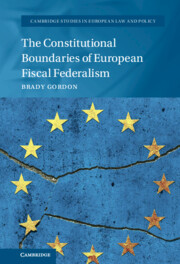Book contents
- The Constitutional Boundaries of European Fiscal Federalism
- Cambridge Studies in European Law and Policy
- The Constitutional Boundaries of European Fiscal Federalism
- Copyright page
- Basic Table of Contents
- Detailed Table of Contents
- Figures
- Acknowledgements
- Table of Cases
- Table of Legislation, Treaties and Conventions
- Abbreviations
- Part I
- Methods and Introduction
- 1 The Constitutional Boundaries of European Fiscal Federalism
- 2 The Maastricht Architecture of European Fiscal Federalism
- 3 The Failure and Abrogation of the Maastricht Model
- 4 Constitutional Criteria for EU Fiscal Federalism
- Part II
- Proposed Directions for Future Research and Reform
- Bibliography
- Index
3 - The Failure and Abrogation of the Maastricht Model
from Part I
Published online by Cambridge University Press: 07 April 2022
- The Constitutional Boundaries of European Fiscal Federalism
- Cambridge Studies in European Law and Policy
- The Constitutional Boundaries of European Fiscal Federalism
- Copyright page
- Basic Table of Contents
- Detailed Table of Contents
- Figures
- Acknowledgements
- Table of Cases
- Table of Legislation, Treaties and Conventions
- Abbreviations
- Part I
- Methods and Introduction
- 1 The Constitutional Boundaries of European Fiscal Federalism
- 2 The Maastricht Architecture of European Fiscal Federalism
- 3 The Failure and Abrogation of the Maastricht Model
- 4 Constitutional Criteria for EU Fiscal Federalism
- Part II
- Proposed Directions for Future Research and Reform
- Bibliography
- Index
Summary
In order to extract economic criteria for European fiscal federalism, Chapter 3 examines public accounts statistics and the economic literature on EMU from 1992 through the European sovereign debt crisis. It follows a chain of macroeconomic indicators running from nominal interest-rate convergence to the sovereign debt crisis. It examines nominal interest-rate convergence; structural determinants of sovereign bond yields; real interest rates; private-sector domestic credit; cross-border credit flows; consolidated banking claims; current-account imbalances; real effective exchange-rates; public and private-sector debt; the sovereign-bank feedback loop; and fiscal policy. The analysis finds that the Euro Crisis was a private debt crisis, not a public one. The causa sine qua non of the crisis is a severe mispricing of private and public debt caused by a failure of Articles 121-126 TFEU to induce markets to differentiate between sovereign borrowers under a (now realised) bailout expectation – not sovereign debt.
Keywords
- Type
- Chapter
- Information
- The Constitutional Boundaries of European Fiscal Federalism , pp. 137 - 198Publisher: Cambridge University PressPrint publication year: 2022
- 1
- Cited by

